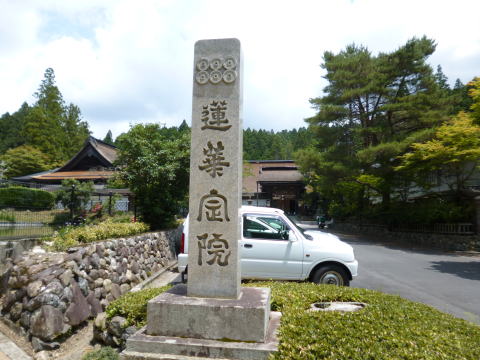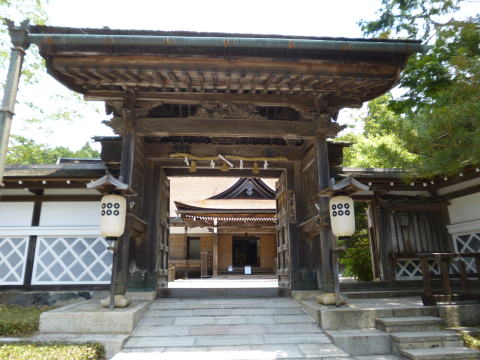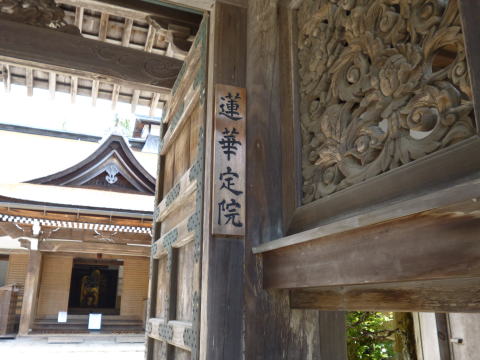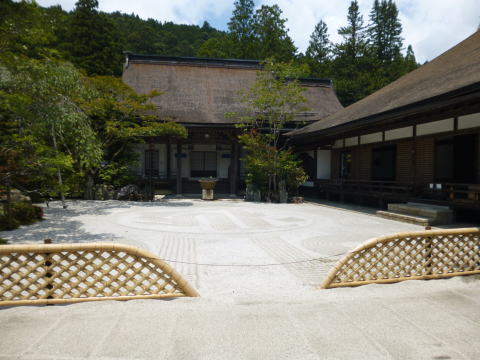Rengejo-in temple ![]()
Rengejoin is a special head temple of the Shingon sect located in Isshindani,
Koya-cho, Wakayama Prefecture.
The principal image is the Amida Buddha (made by the Buddhist carver Kasuga).
It is said to have originated as Okubo Nembutsu-in, where Gyosho Shonin
(1130-1217) began practicing Nembutsu(chanting) in his later years, and
was built during the Kenkyu era (1190-99).
This is where Samurai Sanada Masayuki and Yukimura first sought refuge
after being ordered to live in seclusion after their defeat in the Battle
of Sekigahara.
The Sanada clan's flag, six-mon coins, are displayed throughout the temple.
Later, they were allowed to live with their wives and children, and moved
from Mount Koya, where women were not allowed to enter at the time, to
Kudoyama, which was on temple land.
The temple has around 150 documents dating from the late Muromachi period to the end of the early modern period.
Many of the documents are deeds for lodgings, including those of the Tomono
clan of Shinano Tomono-sho and Sanada Masayuki of Sanada-go, and the temple
served as a lodging facility in various regions of Shinano until the end
of the early modern period.
Letters from Arima Harunobu and Asano Yukinaga, known as Christian daimyo, have also survived.
The temple treasure, a sword made by Fujiwara Kunihiro, was made by Oki Shonin (1536-1608) and donated to Rengejoin, and is designated as an Important Cultural Property of Japan.
The handwritten letters of Sanada Yukimura (one volume of Shochu no Bun and two letters of Amano Pilgrimage Notices) were written when Yukimura was retiring to Kudoyama, and are designated as Cultural Properties of Wakayama Prefecture.
Take the bus from Koyasan Station to Kongobuji-mae busstop, and walk for ten minutes.





Six coins clan's flag
The Sanada family adopted the "Rokumonsen," or Six Mon Coins,
as their family crest for a symbolic reason.
In Japanese culture, it was believed that six coins were the necessary
fare to cross the river to the afterlife.
By choosing this emblem, the Sanada family demonstrated their preparedness to face death with courage and honor in battle.
It symbolized their warrior spirit and readiness to sacrifice their lives if necessary, reflecting the values of bravery and loyalty that were important to them.
The reason why the six coins are referred to as the fare for crossing the
Sanzu River relates to the concept of Japanese Buddhism.
The Sanzu River is a mythical river in the Buddhist underworld, symobolizing
the boundary between life and death.
According to belief, souls must cross this river to reach the afterlife,
and they pay a fare of six coins to the ferryman for the crossing.
The consept of six mon coins stems from both numerical symbolism and practical
considerlations.
The number six represents the six realms of existence in Buddhist cosmology,
signifying the cycle of reincarnation.
The value of six mon coins is relatively small, making it accessible to
people from all social classes.
This reflects the idea that all souls, regardless of their early status,
must make the journey across the Sanzu River.
Thus, the six mon coins serve as a symbolic fare for traversing the boundaries
between life and death in Japanese Buddhist tradition.
TOP PAGE 観光カレンダー
TOP PAGE 观光最佳时期